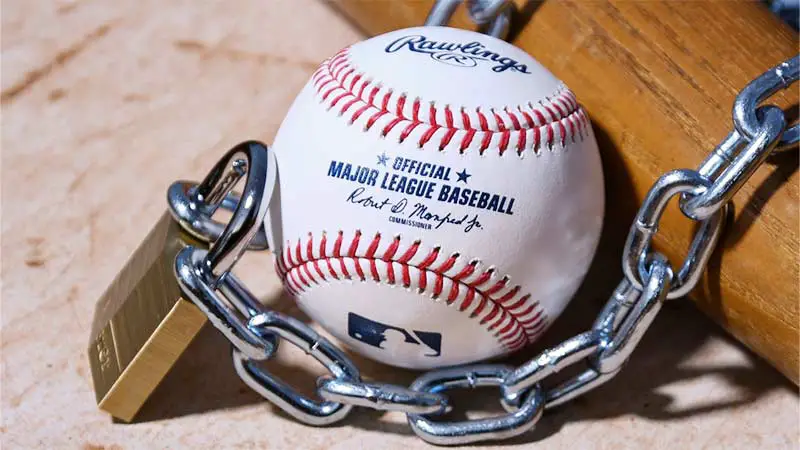The MLB lockout has been a recurring theme in the history of Major League Baseball, often disrupting spring training and creating uncertainty for players and fans alike.
From the 1973 lockout, which saw no games canceled, to the more impactful 1981 strike that wiped out 713 games, labor disputes have shaped the landscape of the sport.
As the 2022 season approaches, it’s essential to understand the events that led to the latest lockout and the new collective bargaining agreement (CBA) that finally ended it.
The CBA, a crucial contract between MLB and the MLB Players Association, covers everything from player salaries to game rules.
With the previous agreement expiring in December 2021, the ensuing lockout marked yet another chapter in MLB’s complex labor history.
Background of the MLB Lockout
The MLB lockout is a labor dispute between Major League Baseball (MLB) team owners and the Major League Baseball Players Association (MLBPA).
Key Issues and Demands
The MLB lockout stemmed from significant disagreements between league owners and the MLB Players Association (MLBPA).
Central to the conflict was the competitive balance tax (CBT), a mechanism to ensure financial parity among teams.
Owners viewed the CBT as vital to maintaining a level playing field, whereas players saw it as a constraint on salaries.
Negotiations also revolved around revenue sharing, expanded postseason fields, minimum salaries, and a draft lottery, with each side aiming to optimize its gains.
Timeline of Events Leading to the Lockout
Here’s a condensed timeline of the events leading up to the MLB lockout:
March 2021
MLB and MLBPA begin negotiations on a new collective bargaining agreement (CBA) to replace the existing one, which expires in December.
July 2021
MLB proposes an expanded playoff format and other changes, but talks stall over economic issues such as revenue sharing and the luxury tax.
November 2021
MLB owners vote unanimously to lock out players if a new CBA isn’t reached by the December 1 deadline. This decision aims to expedite negotiations and avoid disruptions to the 2022 season. Fans and analysts alike are closely watching as both sides work toward an agreement.
December 1, 2021
Deadline for a new CBA passes without an agreement. MLBPA rejects MLB’s final offer, prompting owners to initiate the lockout.
December 2, 2021
MLB lockout officially begins, marking the league’s first work stoppage since the 1994-95 strike. The dispute centers on disagreements over revenue sharing, player contracts, and competitive balance. As negotiations stall, fans are left wondering when America’s pastime will resume.
December 2021 – January 2022
Negotiations continue intermittently but make little progress as both sides remain far apart on key issues. The primary sticking points include salary caps, free agency rules, and revenue sharing, with both players and owners unwilling to compromise. Fans are left in limbo, unsure about the upcoming season.
February 2022
MLB cancels the first two series of the regular season, marking the first time games are canceled due to a labor dispute since the 1994-95 strike.
March – April 2022
Talks between MLB and MLBPA continue, with occasional signs of progress but no breakthroughs.
Both sides have made concessions, yet critical issues like salary arbitration and revenue sharing remain unresolved. Fans eagerly await a resolution as the regular season’s start hangs in the balance.
May – June 2022
Negotiations intensify as pressure mounts to reach a deal before further games are canceled. Both sides make concessions, leading to a tentative agreement on a new CBA.
June 12, 2022
MLB and MLBPA announce they have reached a tentative agreement on a new CBA, ending the 99-day lockout. The deal still requires ratification by both parties.
Major Sticking Points in Negotiations
During the negotiations leading up to the MLB lockout, several major sticking points emerged between the league and the players’ union.
These included:
Players vs. Owners Perspectives
The players and owners had conflicting perspectives during the negotiations. Players expressed concerns about a shrinking percentage of revenue going to them, arguing that creative accounting methods by MLB owners misrepresented their fair share.
Owners, benefiting significantly from the previous 2017-2021 CBA, aimed to maintain the status quo, seeking more profits through expanded playoffs.
Players sought a more equitable distribution of revenues, wanting adjustments to the competitive balance tax (CBT) which they felt acted as a salary cap.
Owners proposed changes like a 154-game season and the universal designated hitter (DH) role, tied to expanded playoff formats, hoping to extract more value without major concessions.
Economic Impacts on the Game
The economic impacts of the lockout were significant. The CBT thresholds increased, growing twice as fast as in previous CBAs. The new thresholds set for each year from 2022 to 2026 escalated from $230 million to $244 million.
Failure to adhere to these CBT limits incurred penalties: 20% for first-time offenses, 30% for second consecutive years, and 50% for three or more consecutive years.
Players viewed these changes as mitigating runaway spending while ensuring limits didn’t unfairly cap their earning potential.
Owners, in contrast, saw penalty structures as ways to control payroll expenditures effectively, ensuring a more predictable financial environment.
The updated economic terms shaped how teams approached free agency, trades, and salary negotiations.
Effects of the Lockout
The MLB lockout has had several significant effects on various stakeholders within the baseball community:
On Players and Staff
The MLB lockout had several significant effects on players and staff. During the lockout, there was no communication allowed between teams and their 40-man roster players, which disrupted training and rehabilitation efforts.
For players rehabbing from injuries, like Lance McCullers Jr., this made the rehab process choppy and less effective.
Coaches couldn’t connect with players to guide offseason preparations, further hampering performance and readiness for the season.
Additionally, teams scrambled to handle arbitration salaries, evaluate Rule 5 Draft picks, and navigate the trade market.
The lockout coincided with critical offseason activities, creating a hurried and disjointed atmosphere once lifted.
Sixteen teams had hired new hitting coaches during the winter, which necessitated rapid introductions and adjustments during a compressed timeline.
This upheaval affected team cohesion and player performance as they adapted to new coaching strategies.
On the Fans and Community
The lockout also impacted fans and the broader community. Fans faced uncertainty regarding the start of the season, leading to diminished excitement and engagement.
With the shutdown of official MLB communication channels featuring current players, fans received limited updates, causing a disconnect.
The relegation of content to retired players, minor leaguers, and miscellaneous topics did little to satisfy the fanbase’s appetite for news on their favorite stars.
Strategies for Resolution
Resolving the MLB lockout requires both sides to engage in constructive negotiations and be willing to make compromises.
Here are some strategies that could facilitate a resolution:
Proposed Solutions by Players
Players have sought several solutions to the lockout issues. They proposed the introduction of a universal DH (Designated Hitter) to enhance game strategy and extend career longevity for veteran hitters.
They also pushed for a reduction of the regular season from 162 games to 154 games, aiming to lessen player fatigue and injuries.
In the realm of revenue sharing, players have called for more transparency and a larger share of overall league revenue. They believe accounting practices have unfairly minimized their cut.
Additionally, they proposed implementing a draft lottery to discourage “tanking” behavior, offering rewards for teams that promote top prospects promptly.
Proposed Solutions by Owners
While specific proposals from MLB owners during the lockout negotiations aren’t readily available, historically, owners have advocated for several key points:
Revenue Sharing
Owners often emphasize the need for a revenue-sharing system that promotes competitive balance across teams.
This could involve adjusting the distribution of league-wide revenue to ensure smaller-market teams can remain competitive with larger-market teams.
Luxury Tax Reform
Owners may propose changes to the luxury tax system to incentivize fiscal responsibility among teams while still allowing for reasonable spending flexibility. This might include adjustments to the tax thresholds or penalties for exceeding them.
Player Salaries and Control
Owners may seek reforms to player salary structures and team control mechanisms to better align with their financial interests. This could involve changes to minimum salaries, arbitration eligibility rules, and free agency timelines.
International Draft
Owners may push for the introduction of an international draft to regulate the signing of international amateur players.
This could help control costs for teams while providing a more structured pathway for international talent to enter the league.
Long-Term Stability
Owners often emphasize the need for a new collective bargaining agreement that provides long-term stability for the league and its teams.
This could involve addressing structural issues that have contributed to labor disputes in the past and establishing a framework for future negotiations.
Frequently Asked Questions
Why did the MLB have a lockout?
The MLBPA wanted higher minimum salaries and better protections for younger players. The league and team owners didn’t agree with the proposals, leading to a negotiation deadlock, which resulted in a lockout when the previous agreement expired.
When was the last MLB lockout before 2022?
The last MLB lockout before 2022 occurred from 1994 to 1995. It was the longest work stoppage in MLB history, leading to the cancellation of the 1994 World Series.
What were the main issues addressed in the new CBA?
The new CBA focused on player salaries, game rules, the competitive balance tax, revenue sharing, and minimum salaries, among other contentious topics.
How did the 2022 lockout affect players and staff?
Players faced disruptions in communication, training, and preparation. Staff and local businesses suffered from reduced revenue due to game cancellations and diminished fan engagement.
What solutions did players propose during negotiations?
Players proposed introducing a universal DH, reducing the regular season length, increasing transparency in revenue sharing, and implementing a draft lottery to discourage tanking.
Conclusion
Navigating the complexities of MLB lockouts requires understanding the historical context and the intricate balance between players’ and owners’ interests.
While the new CBA addresses several contentious issues, the future of MLB remains uncertain. The lockout’s impact on players, fans, and local economies underscores the need for ongoing dialogue and compromise.
As the league moves forward, fans and stakeholders alike will be watching closely to see how these changes shape the game.
The hope is that these adjustments will foster a more competitive and engaging environment for everyone involved.
The lockout serves as a critical juncture for evaluating the long-term health of the league. By prioritizing fairness and sustainability, MLB has the potential to set new standards that benefit all parties.








Pat Bloom